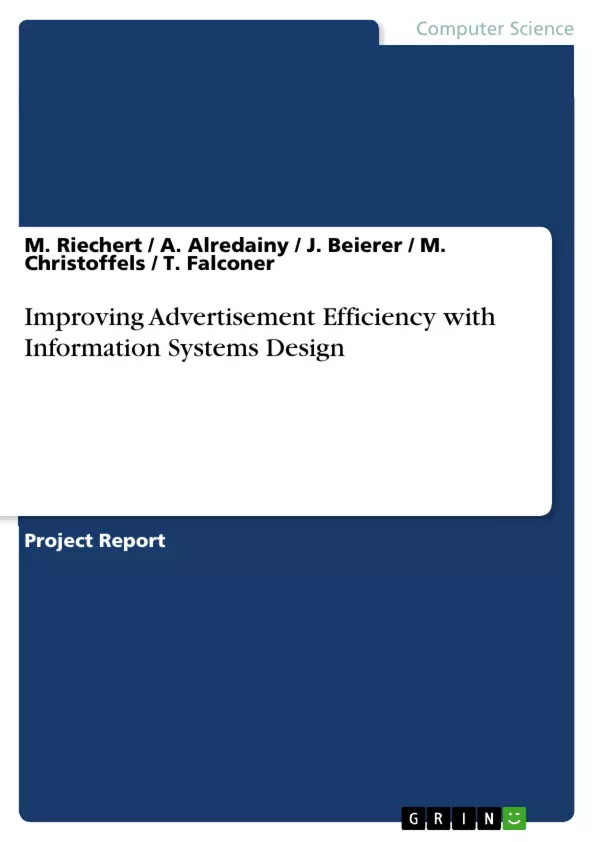This report has been created to successfully analyse a business problem and create the idea for an information system solution to that problem. The business problem chosen is that advertising for businesses is currently ineffective and could be improved thoroughly. Interactive advertising can successfully improve business advertising and therefore the design of ContAD was created. The idea of ContAD was created for users to connect with the content of business advertisements.
ContAD is an interactive advertisement system consisting of a variety of interactive advertising nodes, demonstrated by Figure 5. The advertising nodes are a user-friendly and interactive way of allowing customers to view and search through store deals and advertisements. The interactive advertising nodes consist of a touch screen that provides advertisements of the nearby shop deals. If a user likes a deal the advertising node can provide the user with a direct map to the store, and similar stores on that route. The system is needed because it will successfully improve the business problem that is ineffective advertising.
Throughout this report a number of areas will be covered consisting of: the different types of methodologies but more specifically the chosen waterfall methdology. The design of the project, the team member roles and the project and team dynamics. The information system, the theory regarding the need for the system, the basic idea of the system, the conceptual design of the system and finally a user guide for the system.
Inhaltsverzeichnis (Table of Contents)
- Declaration by group members
- Introduction
- Overview of the conduct of the report
- Systems Development Methodologies
- Detailed Systems Development Methodologies
- The Waterfall Methodology
- Key steps undertaken in the design project
- Team members and their role in the project
- Project and team dynamics
- Conduct conclusion
- The Information System
- Interactive Advertisement System- theoretical basis
- Business Problem Analysis
- The basic design idea of the system
- The conceptual design of the system
- Technical Requirements Analysis
- Architecture of the Information System
- Information about use cases, supported processes and data structure
- Relevant interfaces to other system where required
- A user interface
- Relevant interfaces to other system where required
- The user guide to working with the system
- Information System Conclusion
- Conclusion
Zielsetzung und Themenschwerpunkte (Objectives and Key Themes)
This report aims to analyse a business problem and develop an information system solution. The chosen business problem is the ineffectiveness of current advertising practices. The report explores the use of interactive advertising as a solution, specifically through the design and development of a system called ContAD.
- The ineffectiveness of traditional advertising methods
- The potential of interactive advertising to improve business advertising
- The design and implementation of an interactive advertising system (ContAD)
- The application of systems development methodologies, particularly the Waterfall methodology
- Team dynamics and collaboration in the development process
Zusammenfassung der Kapitel (Chapter Summaries)
The report begins with an introduction that outlines the scope and structure of the document. It then delves into the chosen systems development methodology, the Waterfall methodology, and details the roles of each team member. The report also provides an overview of the project and team dynamics. The next section focuses on the information system itself, exploring the theoretical basis for interactive advertising and analyzing the business problem in detail. The report then presents the basic design idea of ContAD, followed by a comprehensive conceptual design that includes technical requirements analysis, system architecture, use cases, data structure, and user interface considerations. The report concludes with a user guide for the system and a final summary of the project findings.
Schlüsselwörter (Keywords)
The key terms and concepts covered in this report include interactive advertising, business problem analysis, systems development methodologies, Waterfall methodology, information system design, user interface design, ContAD, and team dynamics.
- Quote paper
- B. Sc. M. Riechert (Author), A. Alredainy (Author), J. Beierer (Author), M. Christoffels (Author), T. Falconer (Author), 2010, Improving Advertisement Efficiency with Information Systems Design, Munich, GRIN Verlag, https://www.grin.com/document/171759



